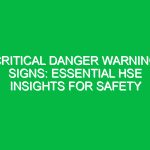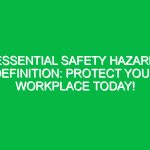Welcome to Today’s Toolbox Talk
Hello team! Thank you for gathering today for this important toolbox talk. As we prepare for our tasks, it’s crucial that we discuss a common yet often overlooked hazard: Poison Ivy. Understanding how to recognize, avoid, and respond to Poison Ivy exposure can significantly contribute to our health and Safety on the job. Let’s dive into the details of this plant, its risks, and how we can effectively manage those risks.
Understanding Poison Ivy
Poison Ivy (Toxicodendron radicans) is a plant that can cause an itchy and uncomfortable skin reaction in many people. It contains an oil called urushiol, which triggers allergic reactions upon contact. This plant can be found in various environments—wooded areas, along trails, and even in urban settings. Recognizing Poison Ivy is the first step to staying safe.
Identifying Poison Ivy
One of the most crucial skills for managing Poison Ivy risks is knowing how to identify it. Here are some key characteristics:
- Leaves: Poison Ivy typically has clusters of three leaflets. Remember the saying, “Leaves of three, let it be.”
- Color: The leaves can be green in the summer and may turn red or yellow in the fall.
- Growth Patterns: It can grow as a vine, shrub, or even a ground cover. Look for clusters of three leaflets that may be glossy.
- Flowers and Berries: In late spring, Poison Ivy produces small, greenish-white flowers and white berries, which can be attractive but are also hazardous.
Where to Find Poison Ivy
Poison Ivy can thrive in various environments. Here are some common places you might encounter it:
- Wooded areas and trails
- Along riverbanks and lakeshores
- In gardens and backyards
- Along fences or walls where it may climb
Understanding where Poison Ivy grows will help you avoid accidental contact.
The Risks of Poison Ivy Exposure
Exposure to Poison Ivy can lead to a painful rash, which is not only uncomfortable but can also disrupt your work and daily activities. The rash typically appears within 12 to 72 hours after contact with urushiol and can last for weeks. Here’s what you need to know about the symptoms:
Symptoms of Poison Ivy Reaction
Common symptoms of a Poison Ivy reaction include:
- Itching and redness
- Swelling in the affected area
- Bumps or blisters that may ooze
If you experience severe reactions, such as difficulty breathing or swallowing, seek medical attention immediately. It’s essential to recognize these symptoms early to prevent further complications.
Real-Life Scenario
Consider a scenario where a team member unknowingly brushes against Poison Ivy while clearing a trail. If they don’t recognize the plant and later touch their face or arms, they could develop a severe rash. This not only affects their health but also their ability to work effectively. By being vigilant and knowledgeable, we can prevent such incidents from occurring.
Preventative Measures: Staying Safe from Poison Ivy
Prevention is key when it comes to managing risks associated with Poison Ivy. Here are some essential tips:
1. Wear Protective Clothing
Always wear long sleeves and long pants when working in areas where Poison Ivy may be present. Consider using gloves and boots to protect your skin from contact.
2. Know Your Environment
Before starting any project, take a moment to assess your surroundings. Familiarize yourself with the areas where Poison Ivy may grow, and plan your work accordingly.
3. Use Barrier Creams
Consider applying barrier creams that can help protect your skin from urushiol. While they are not foolproof, they can add an extra layer of protection.
4. Educate Your Team
Share knowledge about Poison Ivy with your coworkers. The more aware everyone is, the safer we will all be. Encourage open discussions during our toolbox talks about experiences and strategies related to Poison Ivy.
5. Clean Up Properly
If you suspect you’ve come into contact with Poison Ivy, wash your skin with soap and water as soon as possible. This can help remove urushiol before it causes a reaction. Additionally, wash your clothes and any equipment that may have touched the plant.
What to Do If You Encounter Poison Ivy
In the event you come across Poison Ivy while working, here’s a step-by-step guide to follow:
- Stop and Assess: Stop what you’re doing and assess the situation. Avoid touching the plant.
- Notify Your Team: Inform your coworkers of the Poison Ivy’s presence so they can avoid it as well.
- Change Your Route: If possible, find an alternative route that avoids the area where Poison Ivy is growing.
- Report the Location: If you find Poison Ivy on company property, report it to your supervisor so it can be properly managed or removed.
Emergency Response Plan
It’s also vital to have an emergency response plan in place. Ensure that all team members know how to respond if someone is exposed to Poison Ivy. This includes:
- Knowing basic first aid steps for treating a Poison Ivy rash
- Understanding when to seek medical help
- Having contact information for medical assistance readily available
Regulations and Standards
In our workplace, adhering to health and Safety Regulations is paramount. Familiarize yourself with any local regulations related to Poison Ivy management. Compliance not only keeps us safe but also ensures that we meet our legal obligations. Check our company policies on handling hazardous plants and ensure all team members are trained accordingly.
Conclusion
As we wrap up today’s toolbox talk, remember that awareness and education are our best tools against the risks posed by Poison Ivy. By recognizing this plant, taking preventative measures, and knowing how to respond in case of exposure, we can create a safer working environment for everyone.
Thank you for your attention and commitment to safety. Let’s work together to keep our team healthy and protected from Poison Ivy and other Hazards. Do you have any questions or experiences you’d like to share regarding Poison Ivy?


